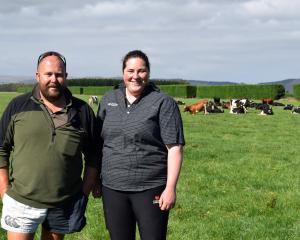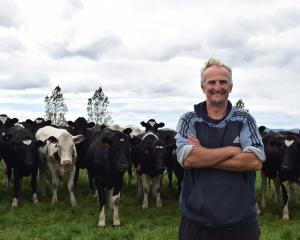
An $100,000 investment has given cows a greater incentive to get to the milking shed on a Clutha dairy farm.
Gareth Bearman, 34, was a boy when his family bought the nearly 250ha Kilkenny Farm, southwest of Milton.
Nugget Point Lighthouse can be seen from the highest point of the hilly farm.
Nearly 450 cows, a mix of Jersey and Jersey cross, were milked on the farm.

About the same time Milo arrived on the scene, a new feeding system, which cost about $100,000, became operational in their 40-aside herringbone milking shed.
The new system was a "wee bit of a learning curve" and had been good so far.
Each cow was served a feed mix of 85% palm kernel and 15% distiller’s dried grains at both milkings each day.
Before the new system was installed, about 500kg of the feed was served in a mobile trough and towed to a paddock for the cows to eat.

The new system in the shed ensured every cow could get its fair share, which ensured the cost for the feed was benefiting the whole herd.
Another issue with the old system was the health and safety risk for whoever was driving the quadbike or side-by-side vehicle to tow the heavy trough across the hilly terrain.
The new feed system allowed staff to use that time to focus on other farm duties.
"It is all done as the cows walk through the shed."

The feed was of good quality and cost effective.
A silo outside the milking shed could hold about 40 tonnes of the feed.
"Basically a truckload and a bit," he said.
Last season, the farm produced 179,000kg of milk solids and was targeting 190,000kg of milk solids this season.
A farm principle was to get the basics right including a fertile herd.

Last season, 79% of the cows in the herd became pregnant in the first six weeks of the mating period.
The nine weeks of mating consisted of five weeks of artificial insemination and four weeks with a bull.
Any cows which were empty after mating were sold.
A tight cost structure was another focus on the farm.
His parents Brendon and Suzie had always been conscious of the costs to get the milk in the vat.

"Mum and Dad have always tried and do most things themselves, which is getting harder as they get older."
They made their own hay and baleage, did their own spraying and applied the fertiliser themselves.
A second staff member was employed last year so his parents could take a step back from the day-to-day farm work as they approached retirement age.
"Old dairy farmers never retire do they?"














